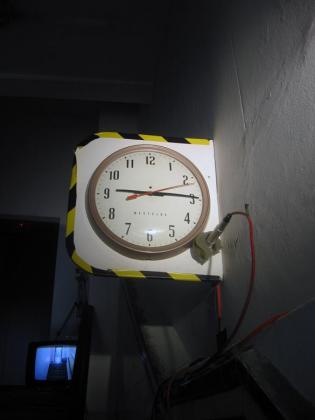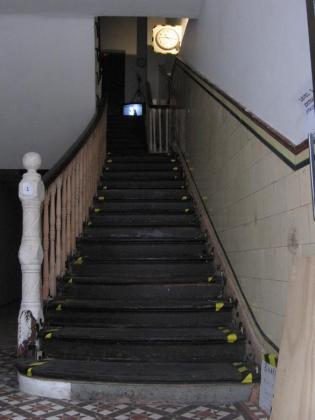joint projects
Newton, forgive me

'Can We Break the Speed of Light?' curator, Emilia Telese, Claremont Artspace 2006.

A set of sensors are installed on a staircase, and are rigged up to a clock, and the clock in turn is mic’d up to an echo unit, amplifier and speakers. As the viewer climbs or descends the staircase, Each contact made with stairs triggers the second hand to move, and the resulting tick is amplified and played back in the space, punctuating his or her movements. The quicker the viewer moves, the quicker the hand moves and the ticking occurs-never allowing the viewer to ‘beat the clock’ and echoing parts of Einsteins theory of Relativity. The more people on the staircase, the more movement and ticking is created and the more time appears to respond to the viewers.
On the first floor, a video monitor of the lift and the space directly in front can be seen. A few seconds after reaching the top of the stairs, a cctv image of time just past catches up enabling the viewer to see the end of their ascent. The cctv intercuts with pre-recorded footage, where the lift doors open and a bright light fills the lift.
John Logie Baird was up to all sort of things before, during and after he arguably invented television. Not only did he have mysterious and secretive practices (hidden behind a very public showmanship) but he also spent rather lot of time working for secret military projects, (in 1924 the Air Ministry opened a file on ‘Experiments in connection with the use of television in aircraft´). Developments such as radar, the telex, fibre optics, nightvision and encrypted signal transmissions can all be credited to Baird.
In the deepest vaults of John Logie Baird arcadia is the idea that he also tried his hand at time travel, that television and radar were merely basic experiments in something far more complex which he sold off to fund his real aspirations. Like other maverick inventors including Edison, Baird entertained thoughts that his prototype invention could be used to contact the dead.
It is a little known fact that Einstein once visited Hastings at the same time that Baird was busying himself with his experiments. The two were even rumoured to have met at the railway station, and whilst waiting for their respective delayed trains, they discussed clocks, then clouds.
Einstein marvelled at the synchronous clock patents coming in at his office in Bern, how they put the whole world in temporal step, shrinking the speed of information criss-crossing the globe. Then, just as his train was finally arriving, he remembered Bairds patent application (GB 292) for his televisor and remarked that it was ´a small box containing the universe´. Baird later described this as ´a proto-theory on television static containing elements from the big bang, the creation of the universe, and the beginning of time.´
As Albert said, ´Reality is a feature of theory used to understand the world, rather than a feature of the world itself. One is in danger of being misled by the illusion that the "real" of our daily experience, "exists really", and that certain concepts of physics are "mere ideas" separated from the "real" by an unbridgeable gulf."
So here we are. A few bits of televisions, some wires, magnets, vacuum tubes, some stepper motors, various audiovisual recording devices, a soldering iron, a few metres of extension leads, clocks, lenses, lightbulbs coated in ebonite, a record player, hatbox lids with holes cut out, a building to work in and heads full of John Logie Baird and Albert Einstein.